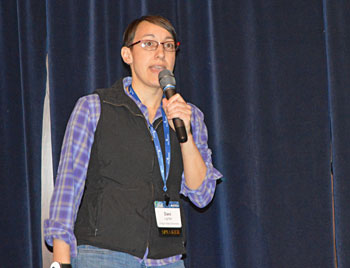New Materials Available, and in the Pipeline, for Blueberries
Oregon blueberry growers saw several new crop protection materials become available for use in 2021 and more are in the pipeline, according to Dani Lightle, IR-4 Specialty Crops Pesticide Registration Research Leader for OSU.
Kanemite 15SC, which is among the materials that became available in 2021, is a miticide with the active ingredient acequinocyl. The material can be a significant addition to grower arsenals, Lightle said, because of its mode of action.
 |
Dani Lightle, IR-4 Specialty Crops Pesticide Registration Research Leader for OSU Extension, at the Oregon Blueberry Conference said several new crop protection materials become available for use in Oregon blueberries in 2021 and more are in the pipeline. |
“Acequinocyl adds a lot to your toolbox, because the two materials for mites that are registered for (bearing) blueberries are both in Group 21A,” she said during a presentation at the Oregon Blueberry Conference, February 14 in Salem. A Group 20B miticide, Kanemite can be applied twice per season. It carries a 21-day retreatment interval and a one-day preharvest interval.
Two other miticides available in blueberries, Acramite and Omite, also offer different modes of action than miticides currently available, but have nonbearing labels only.
Orondis Gold, a premix fungicide of oxathiapiprolin and mefenoxam, is another product that has been available since last growing season in blueberries. Targeting primarily Phytophthora diseases, the product, which can be applied twice a season, is best used early in the season, she said, and needs to be applied with water. “It has to go on with water because it needs to get down into the root zone.”
“Be sure that you are looking at your labels,” Lightle added, “and consider rotating (with other fungicides) so we can maintain the longevity of this material.” Oxathiapiprolin is a Group 49 fungicide, while mefenoxam is a Group 4 fungicide. Ridomil Gold and Metastar 2E are also Group 4 fungicides.
Cevya, another fungicide that became available for blueberry growers in 2021, can be applied three times per season with seven-day retreatment intervals. It contains a 0-day preharvest interval.
Lightle said she couldn’t speak to its efficacy having never worked with it, but noted that Alan Schreiber, executive director of the Washington Blueberry Commission, has worked with it and can be contacted if growers seek more data on the material.
In the Pipeline
Products in the pipeline but not yet available to growers include Parade, a Group 7 fungicide from Nichino with a new active ingredient, pyraziflumid. EPA was scheduled to set a tolerance for Parade in December, but had yet to do so by the date of the Blueberry Conference.
“I saw that they delayed the PRIA date on some other products by about four months,” Lightle said. “If that holds true, you are looking at March or April to see a tolerance set for this particular product.” PRIA, an acronym standing for Pesticide Registration Improvement Act, refers to EPA deadlines for setting tolerances.
Another product in the pipeline, Centaur WDG, or buprofezin, is a Group 16 insecticide that targets scale pests. “It has to go on relatively early,” Lightle said. “It has a 60-day preharvest interval.”
The original PRIA date for the product was in January, Lightle said. “They delayed this one to April, so you might see this one later on this spring.”
Sulfur dioxide, a product for postharvest control of gray mold, has a PRIA date of May 23, she said. “So, depending on how quickly those labels get out, and assuming EPA is on time, that might be available later this season,” Lightle said.
The herbicide Brake On! “is actually an old material that came out of the aquatic weed-management land,” she said. “They are now looking at putting perennial crops on their labels.”
A pre-emergent product, Brake On! could be a good and relatively inexpensive tank mix partner, she said. It has a PRIA date of early next year.
Acramite, or bifenazate, one of the miticides with a nonbearing label, could see a tolerance in about 18 months or so for use in bearing blueberries. “This was just submitted to EPA last month,” she said.
Beleaf, or flonicamid, which targets aphids, has gone through field trials, but it will probably be another year before reports are written and submitted to EPA, she said.
Adavelt, a new fungicide that could potentially target mummy-berry, botrytis and anthracnose, is another product that has gone through field trials and lab analysis, but has to have reports compiled and submitted to EPA.
Field trials and lab analysis also have been completed for PQZ, or pyrifluquinazon, a Group 9B insecticide targeting thrips. Reports have yet to be written for it, too.